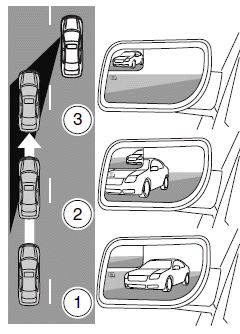Blind spot mirrors (if equipped)

Blind spot mirrors have an integrated convex spotter mirror built into the upper outboard corner of the outside mirrors. They are designed to assist the driver by increasing visibility along the side of the vehicle. For more information on your side view mirrors, refer to Exterior mirrors in the Driver Controls chapter.
Driving with blind spot mirrors
Before a lane change, check the main mirror first, then check the blind spot mirror. If no vehicles are present in the blind spot mirror and the traffic in the adjacent lane is at a safe distance, signal that you are going to change lanes. Glance over your shoulder to verify traffic is clear, and carefully change lanes.
When the approaching vehicle is at a distance, its image is small and near the inboard edge of the main mirror. As the vehicle approaches, the image becomes larger and begins to move outboard across the main mirror (1). As the vehicle approaches its image will transition from the main mirror and begin to appear in the blind spot mirror (2).
As the vehicle leaves the blind spot mirror it will transition to the driver’s peripheral field of view (3).

WARNING: Objects in the blind spot mirror are closer than they appear.
See also:
Engine drivebelt routing
3.7L V6 engine
1. Short drivebelt is on first pulley groove closest to engine (except
vehicles with electric power assisted steering).
2. Long drivebelt is on second pulley groove farthest from ...
Interior
For fabric, carpets, cloth seats, safety belts and seats equipped with side
airbags:
• Remove dust and loose dirt with a vacuum cleaner.
• Remove light stains and soil with Motorcraft Professio ...
Real-time damping
Compared with the fixed-rate dampers fitted to the 2012 MKS, the new CCD
dampers for the 2013 MKS offer dramatically expanded control range.
CCD utilizes an array of 46 inputs to feed data to a sop ...
